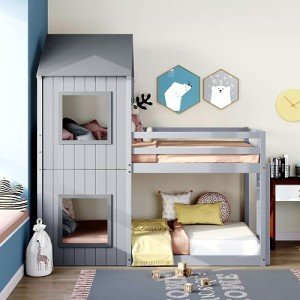A Comprehensive Guide to Children's Bunk Beds: Styles, Benefits, and Safety Considerations
Bunk beds have ended up being a popular option for families wanting to take full advantage of space and offer an enjoyable sleeping environment for children. With their unique style, they provide an innovative and practical service for shared bedrooms, playrooms, and even guest accommodation. This post checks out the numerous designs of kids's bunk beds, their advantages, safety considerations, and answers some often asked questions.
The Allure of Bunk Beds
Kid's bunk beds are more than just space-saving structures; they are likewise an entrance to adventurous dreams and imaginative play. Below is a detailed assessment of their various benefits.
Advantages of Bunk Beds
- Space-Saving: Bunk beds effectively utilize vertical space, making them an ideal choice for smaller rooms.
- Spirited Design: Many bunk bed styles include slides, camping tents, and themed elements, triggering creativity and enjoyment.
- Partner Sharing: Bunk beds are perfect for siblings sharing a room or accommodating slumber parties.
- Versatile Use: Some models can be separated into two private beds, offering versatility as children grow.
- Storage Options: Many bunk beds feature integrated drawer storage or racks, further improving their usefulness.
Designs of Children's Bunk Beds
The variety of bunk beds offered today caters to various choices and needs. Below is an overview of some popular designs.
| Style | Description | Best For |
|---|---|---|
| Requirement Bunk Bed | A conventional style featuring one bed stacked above another. | Siblings sharing a room. |
| Loft Bed | Similar to a bunk bed without the bottom bunk, enables a work area or play area listed below. | Minimal space for play/desk. |
| L-Shaped Bunk Bed | 2 beds arranged in an L-shape, often with additional sections for storage or play. | Unique space designs. |
| Twin Over Full | A twin bed over a full bed, accommodating different sleep needs. | Growing children and teens. |
| High Sleeper | Stands even greater than a loft bed, generally featuring a desk or play location listed below. | Older kids needing more play/desk space. |
| Tent Bunk Bed | Bunk beds with a canopy or tent-like structure, creating a cozy, enjoyable space. | Active and imaginative kids. |
Key Features to Consider
When selecting the right bunk bed for children, the following features deserve considering:
- Material: Bunk beds can be made from wood, metal, or a combination. Recommended Internet site has its unique aesthetic and toughness.
- Weight Capacity: Always confirm the weight limit of the bunk bed to guarantee it can accommodate your kids securely.
- Security Rails: Ensure the leading bunk has strong rails to avoid falls.
- Ladder Security: A well-designed ladder must provide simple and safe access to the upper bunk.
- Finishing: Ensure any finishes are non-toxic and safe for kids.
Security Considerations
Safety is paramount when it pertains to kids's bunk beds. The following guidelines need to be stuck to:
- Age Appropriateness: Generally, kids under six years old should not sleep in the upper bunk due to security dangers.
- Durable Construction: Ensure the frame and products are solid and can support the weight without sagging.
- Routine Maintenance: Periodically examine for loose screws, bolts, or other parts that might require tightening up.
- Clear Play Area: Keep the area around the bunk bed without toys and barriers to lessen tripping threats.
Setting Rules for Safe Use
Developing standards for bunk bed usage will help make sure security:
- Limit Jumping and Climbing: Children ought to be advised versus leaping from the top bunk and climbing on the sides.
- Supervising Sleepovers: Monitor young guests while they are using the bunk bed for the first time.
- Inform on Ladder Use: Teach how to utilize the ladder safely, emphasizing the importance of dealing with the ladder when climbing or down.
Regularly Asked Questions
1. What age is proper for a child to sleep in the top bunk?
The majority of makers advise that kids must be at least six years old to sleep in the upper bunk. This guideline is created to alleviate the threat of falls.
2. Can bunk beds be customized?
Yes, numerous producers provide adjustable choices, including colors, products, and additional functions like drawers or desks.
3. Are bunk beds safe for weight?
Bunk beds have weight limits, usually ranging from 200 to 400 pounds, depending upon the model and product. Always inspect the producer's requirements.
4. How do I keep and clean up a bunk bed?
Frequently look for loose parts, keep the bed tidy by wiping down surfaces, and make sure the bed linen is fresh to promote a safe and hygienic sleep environment.
5. Can bunk beds be separated into specific beds?
Lots of bunk beds feature an option to separate them into two individual beds, offering long-lasting versatility.
Kid's bunk beds are more than mere furnishings; they are a functional, flexible, and imaginative part of a kid's space. With numerous styles readily available and numerous security considerations to bear in mind, moms and dads can pick the best bed that fits their space, meets their children's requirements, and imparts a sense of experience. By comprehending the benefits, styles, and precaution connected with bunk beds, households can develop a wonderful and secure sleeping environment for their children. Whether for brother or sisters sharing a space or space-saving options, bunk beds remain a cherished option for lots of households.

